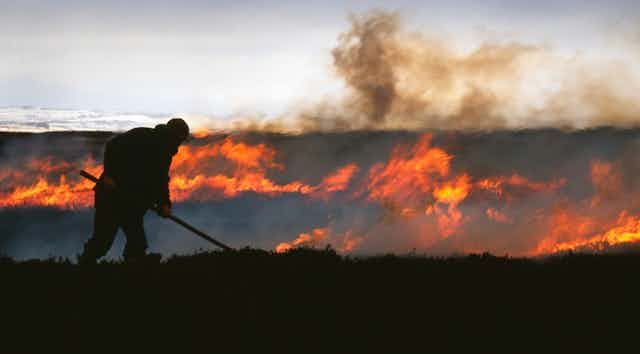Hillsides splashed with purple heather are a symbol of Scotland and its natural beauty. But these picturesque moorlands are actually maintained by people – a practice that is coming under intense scrutiny as the climate crisis escalates.
Scotland’s moorlands are deliberately burned from October to mid-April in a practice known as “muirburn”, which encourages new grass and heather that feeds grouse and livestock. This arrangement suits landowners who shoot these game birds and farmers who graze sheep, but it poses a problem when it happens on peatland.
A healthy peatland is a soggy and spongy terrain made up of partially decomposed plant matter known as peat. Peat soils lock away vast amounts of carbon. In fact, peatlands globally store twice as much carbon as the world’s forests. Peat soils damaged by fire release this carbon, warming the climate. Fire damage can also mean the peat retains less water, and so rain washes more quickly into rivers which increases flooding downstream.

Scotland contains 7% of Europe’s peatlands and their sustainable management is of global importance. In order to address climate change in Scotland, we need to know how much muirburn is happening, and how much of it is happening on peatland,
We made the first assessment of burning on Scottish moorlands over the past 38 years using images from Nasa’s Landsat satellites. These satellites have been snapping pictures of our entire planet every few days since the 1980s. Fires leave behind a burn scar that is visible in these images. Through careful analysis, we can map the areas burned and track changes in burning over time.
We found that the area of moorland being burned increased between 1985 and 2022 – but not by much. Our analysis suggests that there is about as much burning happening now as there was nearly four decades ago.
Up in smoke
We used a dataset that maps out peatlands with the deepest peat soils – at least 50cm deep. These are the peatlands that store the greatest amount of carbon. We overlaid this peatland map on our new muirburn map.
We discovered that the burning of Scottish peatlands is widespread. Almost one-third of all moorland burning in Scotland occurs on peatlands. On average, 1,900 hectares of peatland are burned each year.
Scottish peatlands store a gigantic 1.7 billion tonnes of carbon, equivalent to 140 years of Scotland’s greenhouse gas emissions. Protecting this carbon store is critical – its widespread and intentional burning is alarming.
Moorland burning in Scotland is subject to a set of rules known as the Muirburn Code, which offers guidance and sets out the relevant statutory restrictions. In 2017, this code was revised to suggest burning on peatlands should be avoided.
The amount of burning that has happened on peatlands hasn’t changed since then. Many landowners and land managers continue to burn in defiance of these voluntary guidelines.

The case for new laws
In November 2023, the Scottish parliament agreed to the general principles of the Wildlife Management and Muirburn (Scotland) bill, which would require licenses for people to burn moorland and restrict burning on peatland. MSPs are proposing amendments to the bill which could strengthen or weaken its ability to regulate future burning, so this is a crucial stage of the process.
One argument often made in favour of muirburn on peatland is that burning vegetation in a controlled manner reduces the risk of wildfires. But a major reason that peatlands are susceptible to wildfire in the first place is that they have been drained and in some cases overgrazed by livestock, creating dry and flammable peat.
An alternative way to reduce the risk of wildfires is to restore peatlands by blocking ditches and rewetting the peat. Wet peat is less likely to burn and heather does not grow well on it, so there is less fuel.
Read more: Peat bogs: restoring them could slow climate change – and revive a forgotten world
The Scottish government’s climate change plan aims to restore at least 250,000 hectares of degraded peatland by 2030. This would make sound financial sense. It has been estimated that restoring one-fifth of Scotland’s peatlands would aid carbon storage, water quality and wildlife habitat to the tune of £80 to £288 million.
Satellite images have shown that landowners continue to burn Scottish peatlands even as the climate consequences become ever more stark. In the future, satellites will monitor whether any restrictions imposed by the new bill have been successful.
For now, our evidence should inform the debate on peatland burning within the Scottish parliament. It highlights the scale of the issue and demonstrates that voluntary guidelines to control burning are not working. We urge Scottish lawmakers to develop robust legislation to prevent further damage.

Don’t have time to read about climate change as much as you’d like?
Get a weekly roundup in your inbox instead. Every Wednesday, The Conversation’s environment editor writes Imagine, a short email that goes a little deeper into just one climate issue. Join the 30,000+ readers who’ve subscribed so far.

